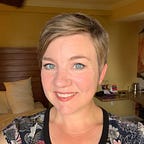Your Cover Letter Should Be About Me, Not You
Hey there, design job seekers. Here’s something I bet you haven’t heard yet:
Include the goddamn cover letter. If it’s good, it will set you apart. And if you’re dealing with a hiring manager who doesn’t read cover letters, it doesn’t hurt anything to include one.
What to write? Use your design thinking skills. When you’re applying to work for me, I’m your end user. Think about what I want to hear.
Here’s how to write a letter that will get you noticed.
Address me by name.
First, make sure to include a greeting. You know you’re writing to someone. Remember your basic writing skills and manners.
Second, make a best guess about the specific someone you’re writing to. LinkedIn exists, and so does CrunchBase. It’s not hard to guess as to the recipient. You might get it wrong, but that’s ok; I’d rather read a cover letter addressed directly to a colleague in Human Resources than read a cover letter addressed to “Dear Hiring Manager.”
Start the letter with what I care about.
The very first sentence should tell me why you’re writing me — even if you’re applying through an online job portal. Include the name of the job, and tell me that you might be a great fit.
The Product Designer role at Teapots, Inc. seems like it would be an excellent match for my background and interests.
But for crying out loud, don’t tell me you are a perfect fit. Compare the above with this:
I am a perfect fit for the Product Designer role at Teapots, Inc.
Let me make that decision, okay? That’s my job.
Here’s another thing I don’t want to read:
I am a passionate, talented designer looking for a job.
I already know that you’re looking for a job, and your passion and/or talent will come through in your portfolio. I don’t need to hear about it here.
Then, tell me a) that you’ve read the job description, and b) how your experience matches my needs.
With over 2 years in the teapot industry, I’m well-positioned to contribute X, Y, and Z skills [that you care about] to your team.
There it is: your two-sentence opening paragraph. As a hiring manager, I now know the following:
- You care enough about applying to this job that you’ve researched the company and me;
- You have some intelligent guesses as to what I need out of the role;
- You’re going to be an employee focused on delivering what your manager needs.
Let’s move on.
Lead every paragraph with what I care about.
Don’t tell me about your personality. And don’t tell me what you will do; tell me what you’ve already done.
At Recent Company, I accomplished X and Y. The business result was Z.
Alternatively:
Your need for X skill matches my background in Y well. Here’s an example.
Don’t tell me what to do.
I once received a cover letter that was likely intended to demonstrate the candidate’s commitment to best practices, but sadly, came across as preachy. It was a list of “musts” and it went something like this:
User research must be performed before moving into design. Prototypes must be made to communicate interaction. The product must be designed mobile-first.
It’s nice that you’re committed to best practices, but you’ve just told me that you’re too rigid to work for me. I work at a startup, and we all need to flex on best practices sometimes.
Also, you’ve just told me that you’ll get frustrated if we don’t design mobile-first. Maybe there’s no mobile use case for the product; does your “must” still hold true? I don’t think so.
End by saying you’re excited to contribute.
Something like this:
I’m interested to learn more about contributing to Teapots, Inc, and I’m excited to speak with you further.
So there you go: a cover letter that is short, clear, humble, and focused on what the hiring manager cares about. If a hiring manager takes the time to read cover letters, this will set you apart from the crowd.
Here it is in its entirety:
Dear Jane:
The Product Designer role at Teapots, Inc. seems like it would be an excellent match for my background and interests. With over 2 years in the teapot industry, I’m well-positioned to contribute X, Y, and Z skills to your team.
At Recent Company, I accomplished X and Y [things that are important to you]. The business result was Z.
Additionally, your need for X skill matches my background in Y. Here’s an example.
I’m interested to learn more about contributing to Teapots, Inc, and I’m excited to speak with you further.
Sincerely,
John
Go forth, and enjoy getting noticed.
